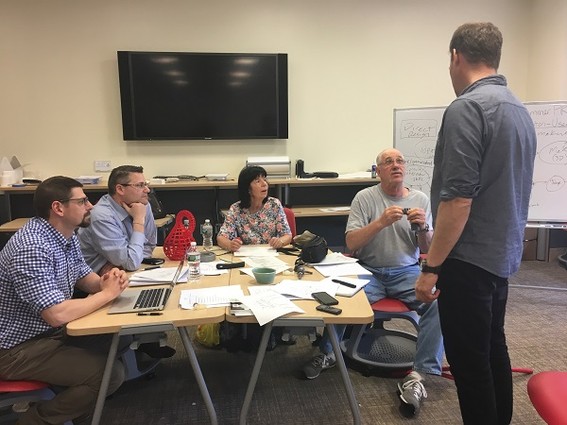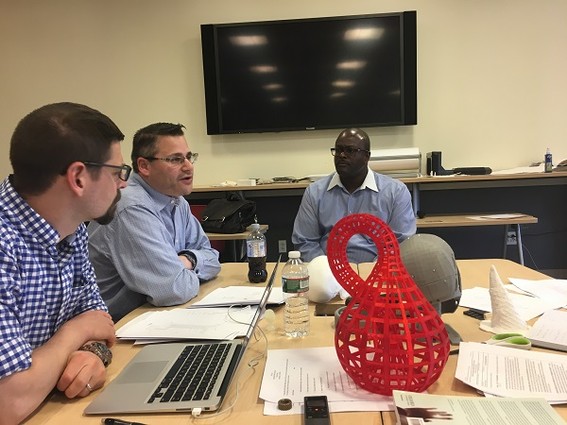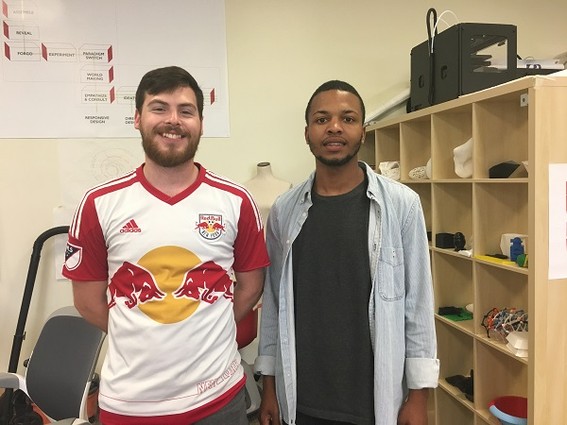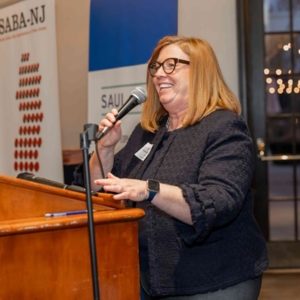Gearhart Law and Feliciano Center Work Together on 3D Printing Prototype Projects

Gearhart Law (Summit) is collaborating with Montclair State University’s 3-D printing MIX Lab on a unique program that allows students at MSU’s Feliciano Center for Entrepreneurship help Gearhart’s intellectual property clients prototype their inventions.
NJTechWeekly.com had the opportunity to sit in with David Postolski, Gearhart law partner, and some of the firm’s clients at the end of June, as they described their prototyping needs to Jason M. Frasca and Iain Kerr, the lab’s codirectors.
Postolski described how he had become involved with the lab. “I have been mentoring the entrepreneurial classes from the start of the program, and now will be teaching entrepreneurial law in the spring semester. Thus, I knew what Jason Frasca was building. At the same time, I currently work with professional prototypers, as our clients need prototypes, and I make it a point to work with these types of service providers.
“When Jason and Iain opened the MIX Lab, I approached Jason and asked him if Gearhart clients could work with his student professionals. We — MSU legal counsel and I — negotiated an agreement, and we were off. For our clients, it’s giving back to the entrepreneurial way and the chance to see their ideas come to life for a reasonable price. We plan to supply the MIX Lab pipeline with as many fun and interesting projects as we can.”
One of those projects was a pop-up book jacket designed by Artie Hoffman, of Angels and Answers, who is a professional psychic, medium and inspirational speaker. The book, which is designed to be a gift item, contains individual chapters that each present an inspiring spiritual thought. “My book cover has angel wings, so when you open it up, you’ll find a slit and you can put someone’s picture in it, say if they are in the hospital” and you want to send them good thoughts. He added that there would be a chip included so that readers can also speak their thoughts.
“I gave the people at MIX Lab my thoughts and ideas on all the specifics of the book, such as how I wanted the wings to overlap, the size of the book. My idea is that you can also put another book in there, so it becomes a jacket. Or you can just put a picture of your loved one in the cover, so when you open it up you see a picture of your loved one.” The MIX Lab will create a prototype based on his concept.

Another client, Chris Wilkinson, brought two projects to the MIX Lab to see if the students could create prototypes. One was a law enforcement drone. The second item the students will prototype is a body dryer for the shower, Wilkinson told us later.
During a fascinating and detailed discussion, clients Robert and Dianne Delikat described the many parts of a device that Robert had developed to hold a gun, so as to improve aim during legal deer hunts. Using 3-D printing, many of the parts could be simplified and consolidated into one part, and items could be made to slide noiselessly, a key point made by Kerr.
Demonstrating his rough prototype, Robert Delikat said, “When I go like this, there can be no noise. Everything has to be quiet. These deer have ears like you wouldn’t believe.”
Kerr and the Delikats discussed the structure of the device and how strong it had to be in order to absorb the gun’s recoil. “We can print in a very strong nylon” Kerr noted. They then discussed the merits of different materials.
“The way this would work is we would get the shape right in a standard plastic, and once the shape was right, we would figure out how to make the parts in a stronger material,” said Kerr. He then explained that the MIX Lab would do the first round of design, get it to work, give the inventors the opportunity to look at it and collaborate on changes if needed. During the second round of design, the device should be finalized. “From there, we will talk about materials,” Kerr said. “If you need some copies made, we can manufacture up to about 12 copies.”

Next, the group talked numbers. The students working on the Delikats’ project would be paid $15/hour. Frasca and Kerr were charged with figuring out the number of hours it was going to take to do the work. That way, if the students took a long time, the Delikats wouldn’t be charged for more than the time the work should have taken. “If you are happy, a request will be made to career services, and career services staffs the job” with students from the MIX Lab who have passed an advanced “master makers” 3-D printing test, Kerr said.
The students were to be supervised by Frasca and Kerr. The results of their work would include a 3-D printing computer file that could be used for computer injection molding. The Delikats wanted a prototype device to take to gun shows, in the hope of selling the license to a manufacturer.
They said that they had met Postolski at a meeting of the New Jersey Inventor’s Club (Cranbury) where they heard him speak. Postolski later filed their patent for them. “He’s been very helpful,” said the Delikats. “This process is so confusing. … You don’t know what to do. … He’s guided us along the way.”
Students Joshua Miller and Altrarik Banks were at the MIX Lab that day. Miller told us that he had finished MSU’s three-part course on innovation, digital design and digital making, and was given the opportunity to work with Gearhart. “As soon as they presented the concept, I jumped right on it,” Miller said.
Asked about being presented with the challenges of creating new and difficult pieces, Miller responded, “How can something be actually rewarding if it isn’t difficult? It sounds exciting and will actually be manageable because a lot of it is part-by-part-based, and we’ll learn how to make the parts better.”
“The lab is almost our second home,” Banks said. “Josh and I were among the first cohorts to complete the three-part course.” Asked about the difficulty involved in the real-world challenges being presented to them, Banks noted, “In the lab, we are involved in interesting making, and I have worked on a lot of things for the first time,” including ceramics recently. “We follow the philosophy of learning by doing.”
Asked how the projects were progressing, Frasca said, “Currently, we have five students designing 3-D models and 3-D prints on three projects. It is still early in the process, yet the students are acquiring invaluable new skills in how to manage client relationships, project management and contract consulting work.
“This partnership has created an opportunity for the students to prepare themselves to be self-sufficient 3-D designers as entrepreneurial consultants or in an agency setting. This is something we are very excited about.”

